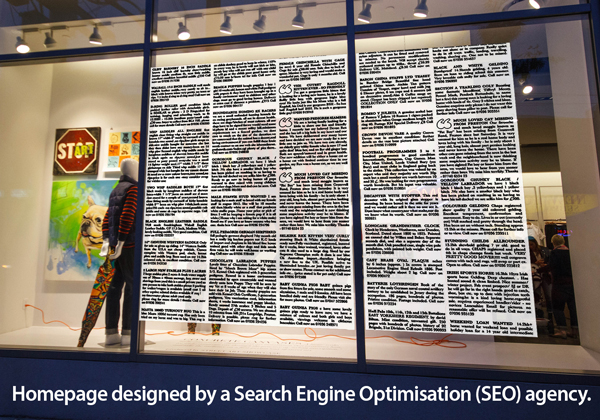
Designers generally design for humans. Human-centric design makes sense as the consumers/users are humans. There are key principles and best practices governing structure, content, and presentation. These are factors that affect a design’s accessibility, usability and attractiveness.
Search Engine Optimisation (SEO) practitioners design for machines. Machine-centric content can help web pages rank higher on search engines like Google and Bing. Prioritising SEO principles can get your site to appear higher in the rankings. But will your new customers be put off when they actually visit your site?

Following SEO principles too obsessively can cause a homepage to become a wall of text.
The homepage is meant to attract and invite customers to enter your site and look around. It should provide a simple overview of what your business is about. What it shouldn’t do is force customers to read a detailed summary of your entire operations before they have even walked into the site proper.
Search engines like to see relevant text, containing keywords and key phrases relevant to the business, divided into headings and subheadings with paragraphs, on the homepage. A couple of sentences is often insufficient, so SEO practitioners end up overloading the homepage with essentially a detailed summary of the entire business!
Search engines also prioritises repeated keywords and phrases. For humans, this subtle repetition exacerbates the annoyance of the wall of text.
Search engine operators are aware of people trying to cheat their algorithms. So they prioritise text that are actually presented to humans – ie the real content – over text that are plonked on the page (lots of keywords set in a tiny font or styled to be white or invisible) with the intention to trick search engines.
Personally I still favour human-centric over machine-centric design as a core approach. Because business is more than just getting a higher search engine ranking. Annoying people when they arrive at your shop-front cannot be conducive to any relationship.
Ignoring SEO principles completely is silly too of course. There must be a reasonable compromise somewhere; a balance of the two concerns.
Search engine algorithms’ ability to discern real content from “tricksy” content should continue to improve over time. Hopefully, we will dispense with the need to specifically design for search engines, and focus instead on making things easier and more meaningful for humans.
Have a look at your homepage, on both a computer screen as well as on your phone. So you see a wall of text? Is that actually helping or hindering your customers?
Images: Joe Fresh Window Display by Gary J. Wood via Flickr CC BY-SA 2.0; Interactive Newsprint - classifieds by Interactive Newsprint via Flickr CC BY 2.0; Cropped and montaged.